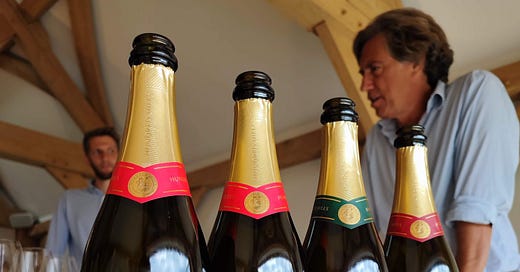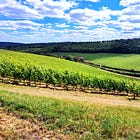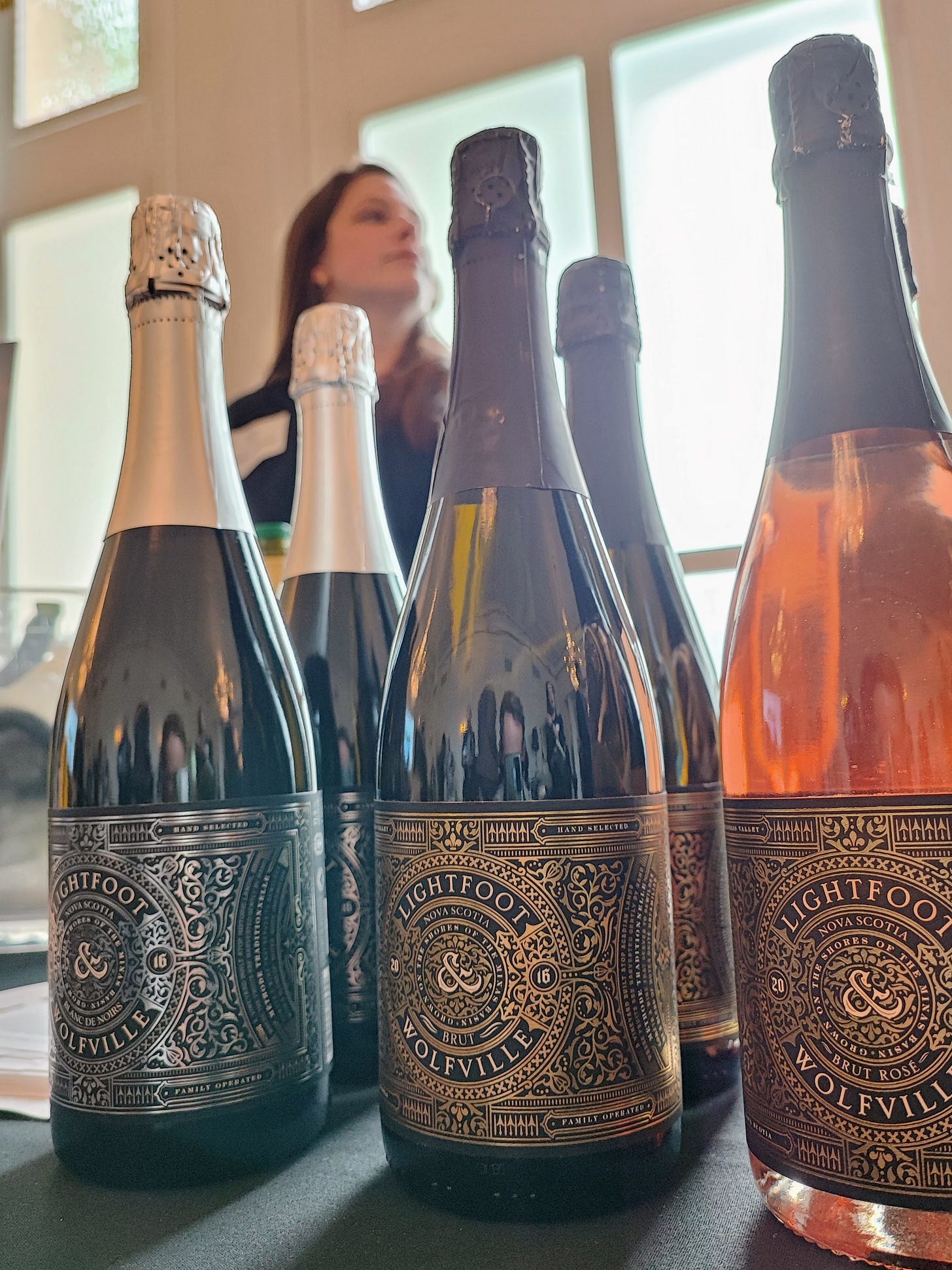England and Canada - Sparkling Wines
Thoughts on recent tastings, plus an auction in aid of the Gerard Basset Foundation
Bubbleheads,
I attended two notable tastings in recent weeks; one of Canadian wines at Canada House on Trafalgar Square, and the other, at the other organised in support of an upcoming auction of English wines in aid of the Gerard Basset Foundation.
First, some of my picks from the England tasting (I’ve also updated the Directory for England, where I keep a running critical list of producers):
Ridgeview, one of the country’s longest-established producers of traditional method sparkling wine, has tended to be a story of one wine for me - the blanc de blancs - so it was great to taste the Limited Edition Rosé de Noirs 2018 in what was no doubt the best vintage I’ve tasted so far. 2018’s warmth and generosity smooths out all the angles that we sometimes get in rosé (and blanc de noirs) in the UK, and it really showed here. There’s a new vintage (2010) of the Limited Edition Blanc de Blancs in Magnum, too, the 2009 vintage of which has long been one of the country’s most refined wines (it top-scored in one of my timatkin.com England reports). Is it as good as the 2009? The magnum tasted was actually a little more evolved than I was expecting, but this is clearly still top-drawer English Blanc de Blancs in a clean-cut, restrained frame.
Tasting at Hundred Hills back in 2022
Hundred Hills, in Oxfordshire, is quite a remarkable producer in many ways; they certainly raised a few eyebrows by planting a very high elevation chalky site of mixed aspect in the Stonor Valley, aided by well-known sparkling wine consultant Miguel Salgues, previously of Roederer Estate in California.
I visited during 2022 and found the vines a good few weeks behind some other producers I was visiting, and wondered what would happen in a cool, late year here. After some impressive 2018s, along came 2019 - a trickier, later vintage during which I remember picking some grapes in sodden rain at very low alcohol levels in Sussex - and, lo, Hundred Hills appear to have come through well. Stephen Duckett is convinced he has an exceptionally dry site, with long hang-times and, despite the late harvests, fine fruit quality (something notably lacking from one other late-ripening chalky vineyard of slightly controversial site selection….).
The Blanc de Noirs 2019 and Rosé de Saignée 2018 (with its fairly forthright but undeniably tasty oak character) impressed here. These wines also seem to capture what, to a Champagne nut, certainly feels like some real chalkiness - yes they’re strict, narrow things, but there’s more going on to raise the voltage than fruit austerity and acids.
Next, it was a real pleasure to talk to Josh Donaghy-Spire of Chapel Down who was presenting what was the best-tasting lineup of Chapel Down wines I can remember tasting in recent years. Chapel Down are such an important producer for England, and it’s great news that the portfolio seems to have settled a little and the quality of entry Brut was notably up on the editions I tasted for the Tim Atkin reports in 2021 and 2022. Grand Reserve 2018 is the best sparkling wine outside of the premium Kit’s Coty Range that I’ve tasted from Chapel Down.
It’s no news that Gusbourne continue to excel with Blanc de Blancs, blending their original Kent sites with chalky Sussex fruit. Magnums of 2016 stood out for a perfect balance of maturity and zip - seriously refined stuff, and for me the top vintage of this wine. There’s a 3D, no-gaps fruit quality to Chardonnay here that lifts it above many English Blanc de Blancs. The Extra Brut Agrafe, what Gusbourne believe to be the first English Sparkling wine with bottle fermentation under cork (rather than crown cap), was also very good, although I wondered whether even longer on cork would magnify it further. It’s in these magnums and late releases where my money would still go over the Prestige Cuvée 51N.
For wider, unbiased and critical thoughts on English Sparkling Wine producers please take a look at:
The Directory - English Sparkling Wine
Hundred Hills, Oxfordshire I’ve tasted many hundreds of English sparkling wines over the last two years, with two reports available at timatkin.com. Here’s a paragraph (or more) on each producer I’ve encountered - these aren’t producer profiles or notes on individual wines, but quick opinions on producers as a whole based on recent tastings and visits.
Canada
There was a decent handful of Canadian sparkling wines on show at Canada House. Nova Scotia, where there are 1500 acres of vines all within 20km of the coast is a cool, late-ripening region where cold-hardy hybrid grapes, which don’t mind the extreme lows of winter here, are just as important as more sensitive vinifera (Chardonnay and Pinot Noir). The polar vortex of winter 2023 actually killed off a lot of Chardonnay at Benjamain Bridge; this isn’t a region like England where climate change is going to push varietal choices inevitably towards international varieties as long as winter cold remains an issue.
The style at Benjamin Bridge is taut, tangy and lightly savoury - the entry NV brut, which uses some fragrant, blossom-like Acadie Blanc alongside Seyval Blanc and Chardonnay from reserves, is a good example of how blending can take the best parts of these non-classic varieties.
Blomidon Estate, also in Nova Scotia, showed a range of sparkling wines of which it was the Brut Reserve, 90% Chardonnay and 10% Pinot Noir bottled in 2019, which impressed with tangy lime, meadow flowers, toast and a smoothed-out texture. I also liked the 100% Acadie Blanc ‘Cuvée l’Acadie’, with its honey, peach blossom and zingy lime cordial nose, a little more rounded and approachable. You can see why Acadie has a place here.
The sparkling stars, though, were best-aligned at Lightfoot & Wolfville, also in Nova Scotia, where a 2021 Brut Rosé from Pinot Noir and Pinot Noir was my favourite wine of the day. Delicate but complete in cherry, fresh almond and cream, bright and tart without some of the sweet-sourness that can pop up in ultra-cool climate fizz. There was also the most refined Chardonnay here, too, in the Brut 2016, all bramley apple, fennel and greengage caught at a good stage of ageing, but particularly the Blanc de Blancs 2015 with quince, cooked lemon and pear fruit, mature but still aligned and working together. There was also a very pretty Blanc de Noirs 2016. This is a smart producer.
I can’t say that the Inniskillin Sparkling with Icewine Dosage 2017 really worked for me - some of the volatility of the icewine Vidal dosage seemed very present. Of the bigger producers the Henry of Pelham Cuvée Catherine Brut was perfectly sound, if rather sweet. Elsewhere there were a few other bubbles, but it was the still wines - especially those from Leaning Post Wines and Haywire that impressed (although I didn’t taste everything).
Opinion - ultra-cool balance
A challenge shared by both ultra late-ripening, cool season sparkling wines is the integration of lees ageing with what can be quite quiet, tight fruit that never really wakes up. In those years spent waiting for it to ‘open up’, the lees-ageing itself ends up dominating the wines, which can taste sort-of impressive, for a few sips - creamy, textured, nutty-umami sometimes - but can quickly get tiring if there’s no energy in the fruit itself. It’s like putting a grumpy uncle in a fluffy Christmas jumper.
A lot of producers in Canada were blocking (or perhaps not attempting) malolactic, too, which I understand on one level, although the idea that malic acidity ‘softens’ always seems a bit misplaced to me; sometimes it would seem to make the job of dosage a little trickier and more prone to a sort of sweet-sour balance that is OK for a glass, but tiring for much more.
And it’s the bottle test that matters, isn’t it? I sometimes feel that critics, in our hunt for technical detail and tasting notes, miss what I observe very ‘normal’ drinkers picking up on; essential drinkability. This seems especially true of ultra-cool climate regions, where acidity and austerity can be exciting for a few sips. I think it even contributes to a sort of communal cellar-palate, where journalists, reviewers and winemakers confer on ‘exciting’ wines that are actually quite challenging to a lot of drinkers. Has this happened in England to some degree?
At least we now have an answer - if your wines aren’t good until the end of the bottle, you can reduce the bottle size!
What excites in these places is when the raw material is doing the talking, and the amplifications of winemaking are propping it up - but not attempting to fix it.









Sorry Substack cut the end off this - it meant to say 'propping it up, not trying to fix it!'